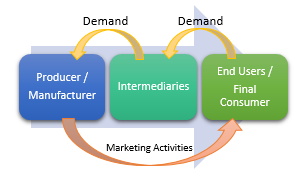The PULL strategy or ASPIRATION strategy or TUG strategy is the New Age marketing scheme; that of the image, of the representation and, in a single word, that of the mark.
If you are facing a solid brand you do not need to push sales because they arrive alone. They buy it because it has a reputation, because the demand is bigger than the offer.
Here come brands such as Microsoft, Coca Cola, Ritz, Carlton, Swatch, Corona, Dell, etc.
The strategy “PULL ” (Strategy towards the final consumer), is a strategy of upward sense and therefore, opposite to the strategy “Push”. In other words, the communication is given from the manufacturer to the end user.

What is the Pull Strategy?
The Pull Strategy is to orient the final buyer’s communication efforts with the promotion and publicity through the mass media, so that the final consumer demands the manufacturer’s products at the retail outlets, the Retailer is requested to the wholesaler, and the latter finally to the manufacturer.
In other words, it consists of making strong communication campaigns, so that the consumer demands the product from the Distributor.
What is the Goal of the Pull Strategy?
The aim of the Pull strategy is for the consumer to demand products at the point of sale to force the retailer to stock that product or brand. At the same time the retailer requests the wholesaler and the manufacturer.
As we see we seek the cooperation of distributors in a way that we consider cooperation by force. If distributors do not want to lose customers they must stock up and buy the requested brand. The manufacturer thus reinforces its negotiating capacity in the channel.
In the inverse of the pressure strategy, we are trying here to create forced cooperation on the part of intermediaries, consumers play in some way in this process.
The implementation of this aspiration strategy requires important advertising media, spread over long periods to create this demand and this pressure on distribution.
What is the Pull Strategy For?
The Pull strategy is used to stimulate the final consumer to pull the products, through a better acceptance of the brand, the concept and the product. Encourage him to buy.
The manufacturer directly encourages the consumer or end-user, through marketing tactics, to demand their products from the distribution channel members, who in turn will sue the manufacturer.
What does the Pull Strategy Imply?
Pull strategy implies that the manufacturer has more contact with the final consumer. This can be done through discount coupons, gifts, free samples, among others.
Aspiration strategies in the “business to business” markets require significant investments in promotion in order to reach consumers or end users.
When should I use a Pull Strategy?
Pull strategy is most appropriate especially when brand loyalty is high, consumers have a lot of interest in the category, there are differences between brands, and when the purchase decision is before going to the store.
When we find products very differentiated in the market the strategies that are carried out are of the type Pull (to pull). These strategies are executed with MK actions based mainly on communication actions (publicity, sponsorships, etc.).
For this type of organizations are very important actions in terms of Branding. Brand policy is very important because it is the one that will personalize the product and personalize the differences that we perceive.
Example
Trade Fairs and Sectoral or Multisectoral Exhibitions open to the public: The typical visitor who comes is the individual consumer of the own locality or region where the exhibition is organized. Usually the reason for the attendance is the curiosity or the festive character of the event. Most of the attendees are current or potential consumers of the exposed products.
Usually the exhibitor who participates does it for reasons of image and public relations.
However, other opportunities are also presented such as obtaining information about the consumer profile (age, social status, habits and forms of consumption, etc.) or the application of an aspiration strategy by promoting new products.
The main disadvantage of the “pull ” strategy, in consumer fairs open to the public, is that the impact coverage of communication is limited to an area of local or regional influence.
The “PULL” strategy directs promotional efforts primarily to end consumers in order to increase demand. Thus, the product is required to the marketing channel by the final consumer.
In other words, it could be said that the strategy of “PULL ” refers to letting pull a product or service, particularly when they are looking for it. And The best example of this kind of strategy is what the Yellow pages were or what Google is today. Customer Search our product and get it. Is to be present when one Is wanted.
Although in many cases you may need a mixed strategy, such is the case of new products, when you must inform the end user of their existence and benefits. Also because the intermediaries must be persuaded to work and make the initial purchase.
Therefore, both the thrust and the attraction are crucial in this introductory stage. You should always start with the push so that when the end user goes to look for the product, you can find it.
